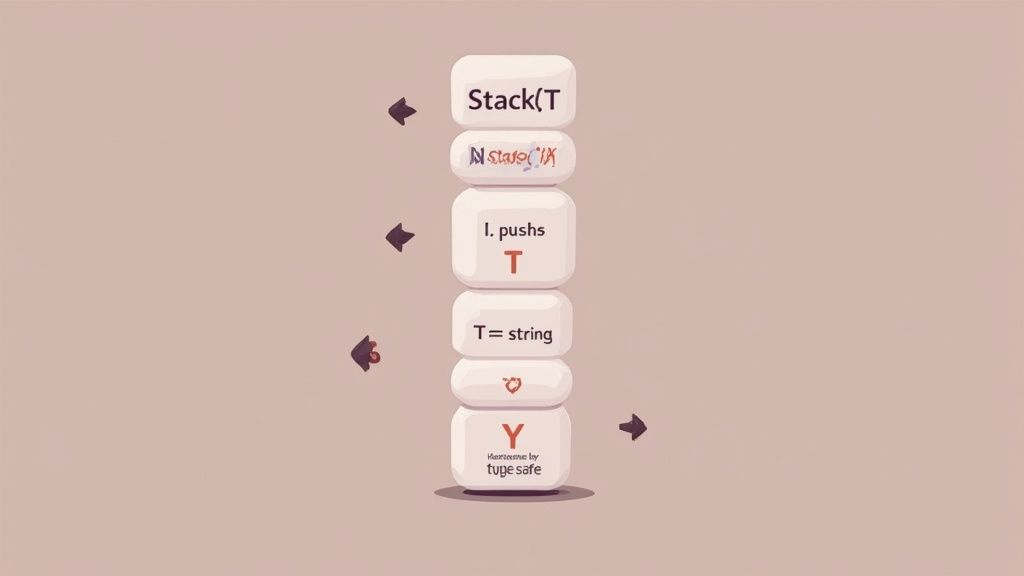TypeScript has become a core competency for modern software development. As its adoption skyrockets, so does the demand for engineers who can wield its type system with precision and strategic foresight. Demonstrating this expertise under interview pressure, however, presents a unique challenge that goes beyond recalling basic syntax. This guide moves past simple Q&A lists […]

TypeScript has become a core competency for modern software development. As its adoption skyrockets, so does the demand for engineers who can wield its type system with precision and strategic foresight. Demonstrating this expertise under interview pressure, however, presents a unique challenge that goes beyond recalling basic syntax. This guide moves past simple Q&A lists to provide a more strategic resource.
We've compiled a comprehensive roundup of interview questions on TypeScript, meticulously categorized by experience level. You'll find everything from the foundational concepts a junior developer must master to the complex architectural scenarios faced by senior and principal engineers. Each question is designed not just to test your knowledge, but to reveal your problem-solving approach, your understanding of technical trade-offs, and your ability to write clean, maintainable, and robustly type-safe code.
This article provides detailed answers, evaluation criteria for hiring managers, and practical follow-up prompts to help you navigate real-world technical discussions. We cover key areas such as:
While mastering these TypeScript specifics is crucial for a technical assessment, don't overlook broader interview readiness. For a comprehensive guide on general preparation, exploring essential job interview practice questions can help round out your approach. Whether you're aiming for your first TypeScript role or a senior position at a leading company, this curated list will equip you with the insights needed to showcase your true capabilities and confidently tackle any challenge thrown your way.
This foundational question is a cornerstone in any set of interview questions on TypeScript, designed to gauge a candidate's grasp of the language's core value proposition: static typing. The interviewer wants to confirm that the candidate understands how TypeScript's type system catches errors during development (compile-time) rather than during execution (runtime), which is a fundamental shift from plain JavaScript.
The discussion will often start with primitive types (string, number, boolean) and quickly move to more complex structures. A strong candidate can clearly explain concepts like union types (allowing a variable to be one of several types, like string | number) and intersection types (combining multiple types into one, like Draggable & Resizable). The ability to articulate the role of type inference, where TypeScript automatically deduces a variable's type, is also crucial.
any (disables type checking), unknown (a type-safe alternative to any), and never (represents a value that will never occur).typeof or instanceof to safely narrow a union type within a code block.any vs. unknown: Articulate a scenario where unknown is superior to any for type safety, forcing you to perform explicit checks before using the variable.This question moves beyond basic type annotations to assess a candidate's ability to write reusable, type-safe components. The interviewer is probing for an understanding of how generics allow developers to create functions, classes, and interfaces that can work over a variety of types rather than a single one. This is a crucial concept in many interview questions on TypeScript, as it signifies a deeper, more architectural way of thinking about code.
A candidate should be able to explain that generics are like placeholders for types. For example, a generic function like function identity<T>(arg: T): T { return arg; } can accept any type T and will return a value of that same type, preserving type information throughout. The conversation will likely extend to generic constraints, such as using extends to require the generic type to have a specific shape (e.g., <T extends { length: number }>), which is essential for creating flexible yet robust APIs.
keyof: Discuss a practical use case, such as creating a function that safely accesses a property on an object: function getProperty<T, K extends keyof T>(obj: T, key: K).React.FC<Props>) or in API service layers for handling different response data structures (function fetchData<T>(url: string): Promise<T>).This is a classic conceptual question among interview questions on TypeScript, probing a developer's understanding of two primary ways to define object shapes. The interviewer wants to see if the candidate can articulate the subtle but important differences between interface and type alias, and more importantly, when to choose one over the other. A great answer goes beyond the syntax to cover practical implications like extensibility and use cases.
The conversation usually centers on the core difference: declaration merging. Interfaces are "open," meaning you can declare the same interface multiple times, and TypeScript will merge their definitions. Type aliases are "closed" and cannot be redefined. A proficient developer can explain how this makes interfaces ideal for creating extensible types, especially in libraries or plugins, while types are better for defining unions, intersections, or more complex composite types.
interface and type often comes down to convention and specific use cases. This question reveals if the candidate thinks pragmatically about code structure and team standards.interface is extended in a separate declaration, a feature impossible with type. Mention its utility for augmenting third-party library types.class User implements IUser), while type is better for creating aliases for other types, like unions (type ID = string | number).This practical coding question moves beyond theoretical knowledge and into applied skills, assessing a candidate's ability to build reusable, type-safe components. The interviewer presents a common computer science problem: create a Stack (a Last-In, First-Out data structure) using TypeScript generics. This task reveals if the candidate can translate an abstract data structure into concrete, flexible code that works with any data type.

A successful implementation involves defining a generic class, like Stack<T>, and implementing core methods such as push(item: T), pop(): T | undefined, and peek(): T | undefined. The use of <T> is central, as it ensures that a Stack<number> can only hold numbers, and a Stack<string> can only hold strings, preventing runtime errors. The interviewer will look for clean implementation, proper use of generics, and attention to edge cases.
isEmpty() or size().IStack<T> interface first. This demonstrates a good design practice of coding to an interface, not an implementation.pop() and peek() methods, explicitly check if the stack is empty. Returning undefined or throwing a custom error are both valid approaches, so be prepared to justify your choice.T is used consistently across the class and its methods to enforce type safety. For example, the push method's parameter should be of type T, and pop should return type T (or a union including it).This practical coding challenge moves beyond theoretical knowledge to assess a candidate's ability to build robust, real-world functionality. The interviewer will ask the candidate to create a generic, reusable function for making API requests. This task tests several key TypeScript skills in a single, integrated problem, revealing how a developer bridges the gap between static types and dynamic data from an external source.
A strong solution will typically involve async/await syntax for handling promises and the use of generics (e.g., function apiRequest<T>(...): Promise<T>) to allow the caller to specify the expected shape of the success response. The candidate must also demonstrate sophisticated error handling, moving beyond a simple try...catch block to create a typed error structure that provides clear, actionable information when a request fails.
Result type or discriminated unions) that improve application stability.async function fetchData<T>(url: string): Promise<T> to ensure the returned data is strongly typed from the outset.Result Type: Showcase advanced error handling by creating a discriminated union type like type Result<T> = { status: 'success'; data: T } | { status: 'error'; error: ApiError };. This forces the calling code to handle both success and failure states explicitly.Error object, create a specific ApiError class or interface that includes properties like statusCode, message, and details. This makes debugging significantly easier.This practical coding challenge moves beyond theoretical knowledge and tests a candidate's ability to apply advanced TypeScript features to solve a common engineering problem. The interviewer is looking for a developer who can build a robust, type-safe event emitter, a pattern central to many asynchronous and decoupled architectures. The core of this task involves using generics to create a flexible system that links specific event names to specific data payloads.

A successful implementation will define a generic interface for the event map (e.g., { 'user:created': { userId: string }, 'payment:success': { amount: number } }). The candidate must then use features like keyof to ensure that only defined event names can be used for emitting or listening, and mapped types to correctly type the listener callbacks. This ensures that a listener for user:created automatically knows its payload is of type { userId: string }, preventing runtime errors.
keyof, and mapped types, which are essential for creating reusable and type-safe abstractions.keyof: Ensure your on, off, and emit methods use a generic type K constrained by keyof Events. This will provide strong type checking and autocompletion.off method that correctly removes specific listeners to prevent memory leaks, a common issue in event-driven systems. Mention its importance in component-based frameworks like React.This advanced, scenario-based question moves beyond isolated TypeScript features to evaluate a candidate's ability to architect a robust, type-safe state management system. Interviewers present a real-world problem, such as managing a multi-step user authentication flow or an e-commerce shopping cart, to see how the candidate designs the state, actions, and reducers. This is one of the most practical interview questions on TypeScript for assessing senior-level skills.
The goal is to see if the candidate can build a system that is not only functional but also scalable and easy to maintain. A top-tier response will involve creating a clearly defined state shape using interfaces, leveraging discriminated unions for action types to enable exhaustive checks in reducers, and properly handling asynchronous operations, including loading and error states. This demonstrates a deep understanding of how to apply TypeScript to solve complex architectural challenges.
type property on your action interfaces (e.g., { type: 'ADD_TO_CART'; payload: CartItem }) to allow TypeScript's control flow analysis to narrow types within your reducer's switch statement.type AsyncData<T> = { status: 'idle' | 'loading' | 'success' | 'error'; data: T | null; error: string | null; }, to ensure all possible states are handled.reselect for memoized, performant state access. For those working with component-based architectures, understanding these patterns is crucial. You can find more information about building applications with React on hiredevelopers.com.This scenario-based question moves beyond language syntax to evaluate a candidate's architectural and strategic thinking. Interviewers present a common real-world problem: a large, mature JavaScript codebase that needs to be migrated to TypeScript without halting development. The goal is to see how the candidate plans and executes a gradual, low-risk adoption strategy.
A strong answer will detail a phased approach, emphasizing interoperability between the existing JavaScript and new TypeScript code. The candidate should discuss configuring tsconfig.json with settings like allowJs: true to enable coexistence and noImplicitAny: false initially, tightening the rules over time. They should also articulate a strategy for prioritizing modules for conversion, such as starting with high-impact, low-dependency utility functions or new features.
tsconfig.json Strategy: Be ready to explain which compiler options you'd enable at the start (allowJs, checkJs) and which you'd introduce later (strictNullChecks, noImplicitAny) to progressively increase type safety..d.ts): Explain how you would create declaration files for existing JavaScript modules to allow TypeScript files to consume them safely before they are fully converted. This approach is often key when undertaking a large-scale project, similar to those managed during outsourcing custom software development.This advanced, scenario-based question shifts focus from type correctness to type-system performance, a critical area in large-scale applications. An interviewer will present a problem, such as slow compile times or runtime sluggishness tied to type guards, to assess a candidate's ability to diagnose and optimize TypeScript-specific performance bottlenecks. This is not about general JavaScript performance but about how the type system itself can impact development and execution speed.
The discussion might involve analyzing why a large codebase with complex, deeply-nested generic types is experiencing slow incremental builds. A strong candidate can suggest practical diagnostic steps, like using the TypeScript compiler's --diagnostics or --extendedDiagnostics flags to pinpoint which files or types are consuming the most compilation time. They should also be able to discuss the trade-offs between type safety and performance, for example, knowing when a complex conditional type might be better simplified.
skipLibCheck can speed up builds by not type-checking dependency files and how incremental builds work.source-map-explorer to investigate if excessive type-related code (e.g., enums, class metadata) is bloating the final JavaScript bundle.This advanced, scenario-based question moves beyond simple type definitions to assess a candidate's ability to maintain type safety in the complex, unpredictable world of asynchronous operations. Interviewers use this to see how a developer handles promises, API responses, and potential failures, ensuring that the entire data flow, including error states, is strongly typed. This is one of the most practical and revealing interview questions on TypeScript for senior roles.
A typical scenario might involve fetching data from an API where the response could be successful or result in various specific errors. A strong candidate will demonstrate how to type a function that returns Promise<SuccessData | ApiError> and then use type guards to safely handle each case in the .then() or await block. They should be able to discuss strategies beyond a simple try...catch block that swallows type information.
catch (e: any), a senior developer will implement patterns to preserve and narrow error types.status: 'success' | 'error') to create a discriminated union. This allows TypeScript to intelligently narrow the type within conditional blocks.ValidationError extends Error or NetworkError extends Error. This makes catch blocks more powerful when combined with instanceof checks.Result<T, E> types, which explicitly force the consumer of a function to handle both the success (T) and error (E) cases, eliminating untyped exceptions. Libraries like fp-ts can be cited as examples.| Item | Implementation complexity | Resource requirements | Expected outcomes | Ideal use cases | Key advantages |
|---|---|---|---|---|---|
| Understanding TypeScript Types and Type System | Low–Medium (conceptual) | Documentation, IDE support, examples | Fewer runtime errors; improved developer UX | Onboarding, language fundamentals, design reviews | Compile-time checks, inference, better autocompletion |
| Generics and Advanced Type Constraints | Medium–High (advanced types) | Time to learn, examples, test coverage | Reusable, flexible APIs with strong typing | Library design, generic components, reusable utilities | Reusability with type safety; reduced duplication |
| Interfaces vs Types – When and Why to Use Each | Low–Medium (decision rules) | Style guide, docs, examples | Consistent type modeling and clearer API contracts | Public APIs, component props, complex unions | Interfaces for contracts/merging; types for unions/tuples |
| Implement a Generic Stack Data Structure | Low–Medium (practical task) | Development time, unit tests | Working type-safe data structure demonstrating generics | Interview tasks, teaching generics, simple algorithms | Shows generics in practice; type-safe operations |
| Type-Safe API Request Handler Function | Medium (async + types) | HTTP client, error types, tests | Robust typed API client with clear error handling | Frontend/back-end API wrappers, fetch wrappers | Maintains response types, structured error handling |
| Implement a Type-Safe Event Emitter | Medium–High (mapped types) | Advanced TS features, tests, design | Reusable event system with compile-time event checks | Libraries, real-time systems, pub/sub architectures | Strongly-typed events; safer subscription/emission |
| Handling Complex State Management Scenario | High (architecture + types) | Design effort, tooling, comprehensive tests | Scalable, type-safe state and action flow | Large apps (Redux, multi-reducer systems) | Predictable state, typed actions/selectors, fewer bugs |
| Migration and Interoperability Scenario – Gradual TypeScript Adoption | High (strategic & technical) | CI, typings, training, migration plan | Incremental type safety with minimal disruption | Large JS codebases needing gradual conversion | Risk-managed adoption; improved maintainability over time |
| Performance Debugging and Type-Related Performance Issues | High (diagnostics) | Profiling tools, build configs, time for analysis | Reduced compile times and smaller bundles | Large projects with slow builds or bloat | Faster builds, optimized bundle size, clearer bottlenecks |
| Type Safety in Asynchronous Patterns and Error Handling | High (complex async patterns) | Libraries (RxJS/fp-ts optional), tests, error models | Robust async flows that preserve type information | Backends, complex async frontends, streaming systems | Preserves types across async boundaries; explicit error handling |
Navigating a technical interview is more than a test of memory; it's a demonstration of your problem-solving mindset, architectural intuition, and ability to communicate complex ideas. As we've explored, the landscape of interview questions on typescript spans from fundamental syntax to sophisticated architectural patterns. This journey from junior-level type definitions to senior-level performance debugging isn't just about accumulating knowledge, it's about building a framework for thinking in a type-safe manner.
The questions covered in this guide, from implementing a generic Stack to designing a type-safe API handler, are designed to probe beyond surface-level understanding. They challenge you to connect the "what" (e.g., "What is a generic?") with the "why" (e.g., "Why is this a powerful tool for creating reusable, type-safe components?").
Your goal in any TypeScript interview is to transition from being a candidate who knows the language to one who applies it strategically. The strongest candidates do more than just provide correct answers; they articulate the trade-offs behind their decisions.
interface and a type, explain the context. Are you defining a public API shape where declaration merging might be valuable? Or are you creating a union or mapped type that requires the flexibility of a type alias?Mastering these interview questions on typescript is about showcasing your ability to build robust, maintainable, and scalable systems. It proves you can wield TypeScript not just as a syntax layer over JavaScript, but as a strategic tool for reducing bugs, improving team collaboration, and enhancing code clarity.
Key Takeaway: The ultimate goal is to demonstrate that you can use TypeScript's features to make deliberate, informed architectural decisions that benefit the entire development lifecycle, from initial coding to long-term maintenance.
Preparing with these questions and exercises is a powerful step toward securing your next role. You're building a deep, practical understanding that sets you apart. The true value lies not in memorizing the provided answers but in internalizing the logic behind them. Practice by building small projects, contributing to open-source, and refactoring old JavaScript projects to use TypeScript. This hands-on experience will solidify your confidence and your skills.
If you're ready to bypass the noise of traditional job boards and connect directly with companies actively seeking elite TypeScript talent, a specialized platform can be your greatest asset. At HireDevelopers.com, we focus on matching pre-vetted, top-tier engineers with innovative global companies. Our rigorous screening process evaluates the very skills discussed in this article: technical depth, problem-solving prowess, and effective communication. This ensures you are presented with opportunities that truly align with your expertise and career ambitions, allowing you to focus on what you do best: building exceptional software.
For a long time, the software world got developer productivity all wrong. We measured what was easy to see, not what actually mattered. Redefining Developer Productivity Beyond Code Ask any old-school manager how they measured a developer's output, and you'd likely hear about lines of code, the number of commits, or how many tickets they […]

In a world saturated with data, the ability to transform raw numbers into clear, actionable insights is a critical competitive advantage. For CTOs, product leaders, and engineering managers, effective data visualization serves as the essential bridge between complex datasets and strategic decision-making. A well-designed chart can reveal hidden trends and empower teams to act decisively, […]

Think of Key Performance Indicators (KPIs) not as a high-school report card, but as the flight dashboard for your engineering team. These are the critical instruments showing your speed, altitude, and direction, making sure you reach your destination—your business goals—safely and efficiently. At their heart, these are simply quantifiable metrics that track how well your […]
